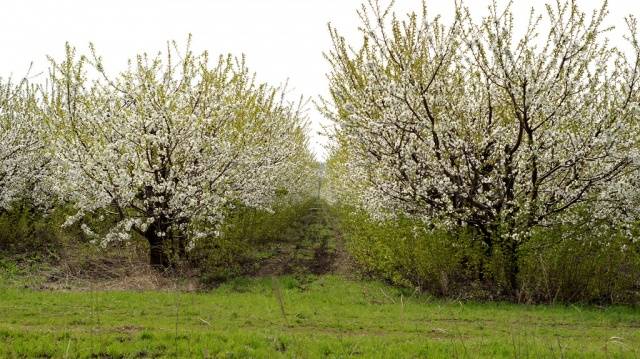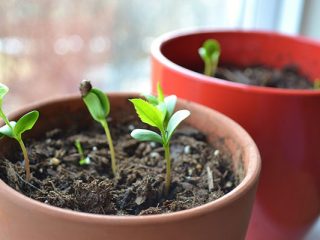Content
The Drogana Yellow cherry was developed quite a long time ago. Like all yellow-fruited varieties, it is distinguished by its exquisite taste and juiciness of the fruit. The popularity of the variety is determined not only by its taste, but also by its good adaptation to various climatic conditions.
History of selection
The origin of the Drogan cherry is not precisely established. It is known that the variety was obtained in Saxony, and received its name in honor of the originator Drogan. The history of the selection of Drogan cherries has not been preserved. As of April 2018, the variety was not included in the State Register.
Description of culture
The Drogan cherry tree reaches a height of 5-6 m. The crown is without excessive thickening, it has a slightly flattened spherical or cone-shaped shape. The plant has smooth and long shoots of light brown color. The leaves are large, up to 17 cm long and 6-7 cm wide.Below is a photo of the Drogana Yellow cherry tree with blossoming flowers.
The size of the fruits is slightly above average, their weight reaches 8 g. The shape of the fruits is heart-shaped, the appearance is bright and impressive. They are firmly attached to the stalks; fall of mature fruits is practically not observed. The color of the hearths is yellow, as follows from the name of the variety. Their skin is very thin. It is smooth and soft to the touch.
The pulp inside the fruit is dense, but at the same time very juicy. It has a straw-yellow color, with barely noticeable veins visible inside the pulp. Separating the pit from the pulp is difficult. The fruits are very sweet. According to tasters, the taste of cherries was assigned 4.6 points on a five-point scale. Photo of Drogana Yellow cherry fruits:
The fruits of the plant contain:
- dry matter – up to 18%;
- sugars – up to 14%;
- acids – 0.2%.
Description of the Drogana Yellow cherry recommends it for cultivation in the North Caucasus and in the lower reaches of the Volga, but its actual distribution thanks to the initiative of gardeners is much wider. Drogana Yellow cherry is currently grown in the following areas:
- Central region;
- Middle lane;
- Baltic countries;
- Belarus;
- Ukraine;
- Moldova.
Reviews of Drogana cherries in these regions note the excellent adaptation of the variety to colder climates and the maintenance of high yields.
Characteristics
The characteristics of the Drogana Yellow cherry variety are considered balanced. The variety combines good winter hardiness, high fruiting, and acceptable resistance to pests.
Drought resistance, winter hardiness
The plant tolerates short-term droughts well; it can survive without watering for up to one month.
The generative buds of the plant are able to withstand frosts down to -35 °C; in addition, late flowering prevents the ovaries from dying from frost in the off-season.
Pollination, flowering period and ripening time
The trees bloom late, usually at the end of May. The plant requires planting of pollinators, although it is considered self-fertile. However, if a tree is planted without pollinators, the yield will be very low. Their maximum distance from the tree should not be more than 35-40 m.
Recommended pollinators for the Drogana Yellow cherry include:
- Napoleon;
- Francis;
- Large-fruited.
Pollinator varieties may have colors other than yellow. This sometimes leads to incorrect selection of pollinators for Drogan cherries, whose flowering dates are earlier. In addition, in some cases it is possible to mislead gardeners by the presence of non-existent varieties. For example, the variety often called black Drogana cherry does not exist in nature, but the Napoleon variety, which is dark red, almost black, may be mistakenly called that.
Fruit ripening dates are the third ten days of June, rarely the beginning of July.
Productivity, fruiting
The yield of the variety is good - in ideal conditions, up to 100 kg of fruits are harvested from the tree. Average yields depend on climatic conditions and proper care; they are 50-70 kg.
According to the description of the cherry variety Drogana Zheltaya, the plant begins to produce crops starting from the 4th year. Fruiting on all branches occurs almost simultaneously.
Area of application of berries
The fruits have low shelf life and poor transportability. Therefore, it is recommended to use them immediately after harvesting: cherries are consumed raw, used in compotes and canning.Freezing the fruits is also not recommended due to cracking of their thin skin.
Resistance to diseases and pests
If you take proper care of Drogana Yellow cherries and carry out preventive measures, mature trees tolerate diseases well and have high resistance to pests. The most common diseases and pests are the same as for other varieties of cherries: gray rot and cherry fly. Like any sweet cherry, this variety can be attacked by birds and rodents.
Advantages and disadvantages
Advantages of the Drogana Yellow cherry variety:
- excellent taste;
- good adaptation to different climate conditions;
- no requirements for soil composition;
- acceptable drought resistance;
- good winter hardiness.
Disadvantages of the variety:
- poor keeping quality and transportability;
- need for pollinators.
Landing Features
All planting procedures for this variety are identical to those for any other cherry variety. The only circumstance that must be taken into account is the relatively large growth of the tree (up to 6 m), which cannot be reduced even with intensive pruning.
Recommended timing
It is advisable to plant Drogana Yellow cherries in the spring, about a month before flowering, that is, in early May. Seedlings purchased in summer or autumn must be stored for two weeks and only then planted. The planting deadline is limited to the second ten days of September.
Choosing a suitable location
The plant loves sunny areas with a duration of sun exposure of 16 to 18 hours. The ideal option would be to plant on the south side of the site, so that there is a barrier from the wind to the north of the plant.The plant is not picky about soil composition, but slightly acidic soils are more preferable. Groundwater should not be closer than 4 m to the surface.
What crops can and cannot be planted next to cherries?
Cherry grows well next to rowan and apple trees. Neighborhood with currants and gooseberries is undesirable. In addition, it is impossible to plant cherries near cherries due to the possibility of cross-pollination. The result of such crossing will be a small number of small and tasteless fruits.
Selection and preparation of planting material
It is recommended to select seedlings for planting that are about three years old. It is advisable to buy them in nurseries with documents or, at a minimum, with tags. The root must have at least three branches. The seedlings themselves must have generative buds.
Preparing a seedling before planting involves removing the leaves from the plant so that they do not attract moisture.
Landing algorithm
The plant is planted in a hole 0.6-0.7 m deep. First, a layer of humus 15 cm thick is placed at the bottom of the hole, or green manure is placed in it, which is filled with infusion of manure. Mineral fertilizers are also added to the pit: superphosphate (up to 500 g) and potassium sulfate (up to 100 g). All this is thoroughly mixed and filled with water.
The seedling is planted after two hours, while the roots of the plant are straightened, the seedling is positioned so that its root collar is 5 cm above the ground. A peg for a garter is driven in next to it. The hole is filled with soil, compacted and watered with a bucket of water. It is advisable to mulch the planting site with peat or freshly cut grass.
Subsequent care of the crop
Caring for Drogana Yellow cherries is standard.During active growing season, flowering and fruiting, regular watering is recommended with a frequency of 15-30 days, depending on the amount of natural precipitation.
Young plants are fed with mineral fertilizers in May and July. Older plants need another feeding at the end of the season. This can be humus or compost in an amount of 10-12 kg, applied under the tree in October.
Preparing the plant for winter includes carefully digging and mulching the soil and wrapping the lower part of the trunk with heat-insulating material, which is especially important for young trees. As soon as the first snow falls, it is advisable to sprinkle the trunk with a snow cone up to 1 m high.
Pruning helps shape the crown and increase the yield of the plant. In addition, sanitary pruning of a tree helps rid it of diseased branches. Pruning is performed twice per season: in spring and autumn. In this case, dry and damaged shoots are always removed.
According to reviews of the Drogana Yellow cherry, to increase yield, it is recommended to trim the current year’s young shoots by about half their length.
Diseases and pests, methods of control and prevention
Let's look at the diseases of the Drogana Yellow cherry variety:
Disease | Fighting methods | Prevention |
tinder | Cutting off the fungal bodies followed by treatment with a disinfectant composition (3% copper sulfate solution) | Treating the trunk with dissolved lime |
Gray rot | Removing damaged fruits and leaves. Treatment with fungicides (Fitosporin or 1% solution of Bordeaux mixture) | Spraying with a 1% solution of copper sulfate or Nitrafemon |
How to get rid of pests:
Pest | Fighting methods | Prevention |
cherry fly | Use of insecticides (Zolon, Calypso, Actellik) | Regular loosening of the soil near the trunk. Application of glue traps |
Pipe screwer | Use of insecticides (Metaphos, Hexachloran) | Collection and destruction of prematurely fallen leaves and fruits |
Birds | Scarecrows, rattles, loud sound synthesizers | Covering the tree with a fishing or fine mesh net. Spraying the tree with a solution of red pepper (infuse 10 pods in 3 liters of water). Using repellent gels, for example, Bed Free |
Conclusion
Cherry Drogana Yellow is a late variety recommended for growing in individual garden plots of small area. Planting and caring for Drogana Yellow cherries is quite simple, even novice gardeners can do it. Fruiting of the plant begins in the 4th year of life. The plant has large fruits and stable yields.
Reviews
Consider the reviews from gardeners about yellow cherries:

















